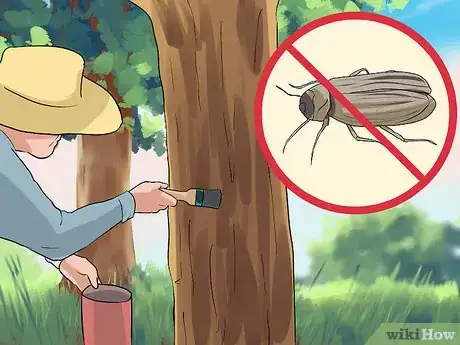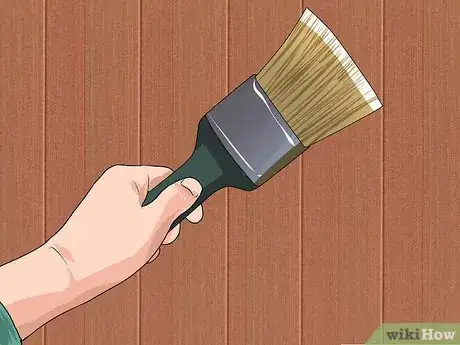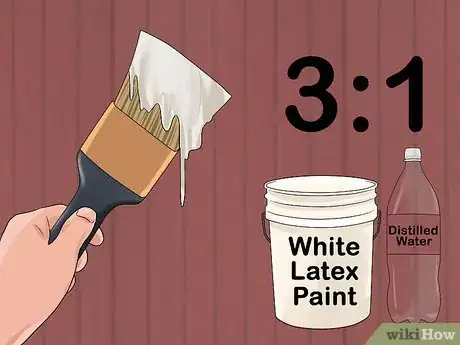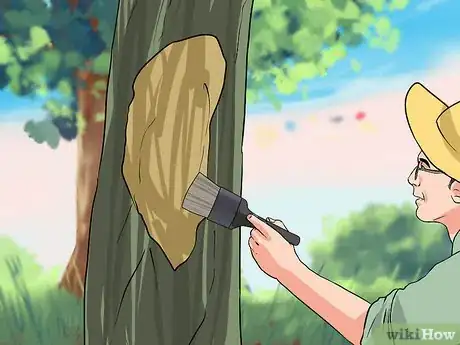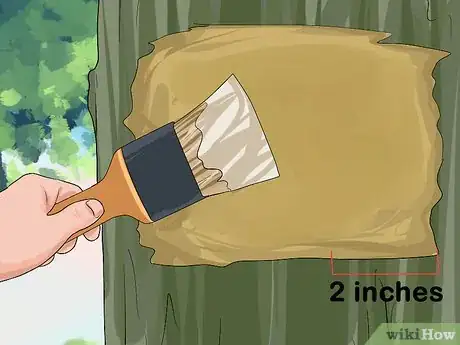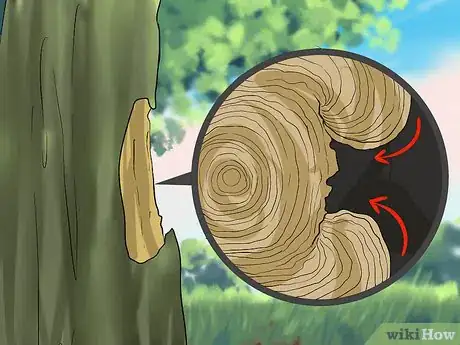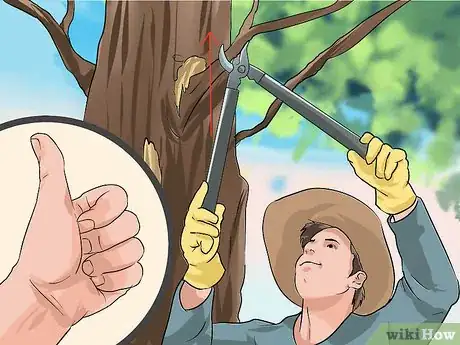This article was co-authored by Katie Gohmann. Katherine Gohmann is a Professional Gardener in Texas. She has been a home gardener and professional gardener since 2008.
There are 10 references cited in this article, which can be found at the bottom of the page.
This article has been viewed 53,023 times.
For many people, including tree professionals and orchard growers, painting trees is a common form of first aid for tree damage from storms or after pruning. Paint can also help trees resist harm from insects, disease, and dehydration. If you want to know how to paint a tree, you have to choose both the paint and the application method. Although painting trees is a common procedure, it is also somewhat controversial. Quite often, it’s actually better to not paint a tree at all but just let it heal itself.
Steps
Protecting Orchard Tree Trunks
-
1Paint the trunks of fruit- and nut-bearing trees. This procedure has been shown to protect against animals that will eat the bark of the tree, and also protects against boring insects that would otherwise work their way into the trees’ trunks.[1]
- Paint trees at least annually in the early spring before insects are active.
- Painting fruit- and nut-bearing trees can also prevent the bark from splitting
-
2Mix distilled water with white latex paint. This mixture is most effective when combined at a 1:1 ratio. You can simply combine 1 gallon (3.79 liters) of water with 1 gallon (3.79 liters) of paint to achieve the proper consistency.
- White paint is more likely to reflect sunlight and, thereby, reduce heat damage.[2]
- Latex paint contains polymer binders to fill and hold splits and cracks.
Advertisement -
3Use a wide, thick, loosely napped paintbrush. This tool will be most effective and help you reach all the cracks in the bark of the tree. Dip your paintbrush into the water/paint mixture until the bristles are about halfway submerged, then withdraw the brush and apply directly to the tree trunk.
- Paint up to the first line of branches. Rodents such as mice, voles, and rabbits will not be able to reach higher than this on the tree, so there’s no need to paint the upper portions of your trees.
-
4Paint from the bottom to the top. This will ensure maximum coverage of the tree trunk, and will allow the paint to seep into gaps or cracks in the bark.
- Allow excess paint to drip down the trunk as you go. You don’t need to wipe up or clean dripping paint.
- Use an airless paint sprayer if speed and convenience are a priority, but make sure paint still reaches into cracks and splits in the bark.
-
5Apply the paint in a thicker ratio if needed. In instances where boring insects are persistent or not discouraged by the 1:1 mixture of latex paint and water, you may need to apply the paint at a thicker consistency.[3]
- Start with a 3:1 mixture of paint to water. If this still doesn’t deter boring insects, you may need to apply the latex paint directly to the tree trunk.
Protecting Damaged Trunk Areas
-
1Identify pruned or damaged areas on trees. This practice is especially common among orchards where trees are pruned. Although there is no substantial evidence to support this claim, painting the wounded or pruned sections of a tree has traditionally been thought to protect the exposed area from invading insects, and to allow the tree to heal more quickly.[4]
- This practice is also commonly referred to as “wound dressing.”
-
2Paint trees to help prevent fungi. Despite the general ineffectiveness of wound dressing to help trees recover from damage, the procedure has been shown to have some use in preventing fungal infection. However, there are also indications that pruning painted trees can trap moisture in the wound – which encourages fungal infection.[5] [6]
- Tree painting may also be useful in preventing oak wilt. This disease is caused by a fungal pathogen, and effects trees primarily in the Eastern United States. Tree paint should be applied to trees pruned or wounded in this region—especially if the pruning is done during the spring or summer.[7]
- Oak-wilt spores are carried by insects, and tree paint is a sufficient deterrent to keep the insects from boring into the exposed tree wood and spreading oak wilt.
-
3Remove loose bark and dirt before you paint. You want the paint to adhere to the cut or wounded portion of the wood, not to any remnants of bark that may still be on the wood.
- It’s best to wear thick work gloves while you’re brushing the bark and dirt off of a tree. Otherwise you may wind up with a hand full of splinters.
-
4Choose a brand of tree paint. Your local hardware store will stock a variety of tree paint brands. Work with the sales staff to choose one that best suits your needs.
-
5Apply a thick coat of commercial wound dressing. When applying, fully cover the wounded or pruned area with a thick layer of paint. In addition to covering the exposed wood, you should also paint up to 2 inches (5.08 centimeters) beyond the edge of the cut.
- This extra coverage will seal the wound’s edges and prevent any boring insects from sneaking in around the perimeter of the painted area.
Choosing an Organic Treatment
-
1Avoid painting damaged trees when possible. Although the method of applying petroleum-based paints to damaged or pruned trees has persisted (and many hardware stores stock wound-dressing products), it has not been shown to help trees.[10]
- Wound dressing trees may prevent the trees from forming callouses, which trees use to protected wounded areas.
- Dark-colored tree paint—especially paint that contains asphalt—on a tree’s trunk will raise the tree’s temperature, often to a harmful degree.[11]
-
2Recognize the potential harms of wound dressing. Contrary to helping a wounded or pruned tree, wound dressing can actually be harmful.
- Painting tree wounds may interfere with the tree’s growth of “scar tissue”-like wood.
- Wound dressing can also seal in excess moisture (which is unhealthy for the tree) and can trap harmful bacteria and fungi inside of the tree.[12]
-
3Assist the tree in healing itself organically. In most cases, trees do not need to be painted in order to resist fungal or insect infestations. Trees already have natural methods of protecting and defending themselves from foreign invaders, and do not need human help.[13]
- If you prefer to take an active role, apply an organic dressing that contains beeswax and lanolin to protect the wound’s surface moisture.
- You may also apply a light coating of insecticide or fungicide to the wounded or pruned wood.[14]
-
4Let the tree compartmentalize the wounded area. Unlike human bodies, trees do not “heal” wounded flesh. Rather, they use a process called compartmentalization, by which a tree can internally seal off damaged areas [15]
- This is a natural process, and one which trees do not need assistance to perform. The scar tissue that develops from compartmentalization protects the tree from fungus and blocks the undamaged parts of the tree from invasive insects.
- Just below the bark on a tree are systems that carry nutrients and fluids throughout the tree. These will transfer nutrients within the tree and help compartmentalize when a section has been damaged.
-
5Prune trees correctly. Often tree wound dressing is applied to poorly pruned trees, in an effort to “heal” them from the effects of poor pruning. If a tree is properly pruned, the tree will not need to be painted.[16]
- When you prune a limb, cut as close to the trunk as you can. Make the cut close to vertical (do not prune tree limbs at an angle). The vertical cut will have a smaller surface area than a diagonal cut, and will leave the tree with less surface area exposed.
- Prune trees in the winter, when their growth has slowed and insect infection rates are lower.[17]
Community Q&A
-
QuestionWhat type of paint is safe to use on a tree trunk?
 Community AnswerAny type of paint will harm the tree.
Community AnswerAny type of paint will harm the tree. -
QuestionDoes the latex paint have to be exterior paint?
 TechdocgeekCommunity AnswerIf the tree is outdoors, that is advised. Exterior paints last longer outdoors than interior paints.
TechdocgeekCommunity AnswerIf the tree is outdoors, that is advised. Exterior paints last longer outdoors than interior paints.
Warnings
- If you use an airless paint sprayer for speed and convenience, recognize that there is possible damage from the paint’s drift on the air, and take precautions to protect the remaining tree and other nearby trees.⧼thumbs_response⧽
- Specific trees in certain regions are particularly susceptible to pathogens entering through wounded areas. In these cases, immediate attention by a professional arborist is recommended.⧼thumbs_response⧽
Things You’ll Need
- Wide, thick, loosely napped paint brush and pail
- Airless paint sprayer
- Drop cloths and rags
- White latex paint
- Distilled water
- Safety equipment, including gloves and goggles
- Commercial pruning dressing
- Orange shellac
- Organic wound dressing
References
- ↑ http://fruitgrowersnews.com/article/painting-tree-trunks-protects-against-rodents-borers/
- ↑ http://fruitgrowersnews.com/article/painting-tree-trunks-protects-against-rodents-borers/
- ↑ http://fruitgrowersnews.com/article/painting-tree-trunks-protects-against-rodents-borers/
- ↑ http://pnwhandbooks.org/plantdisease/pesticide-articles/tree-wound-paints
- ↑ http://blog.davey.com/2016/04/wait-before-you-use-pruning-sealer-on-trees/
- ↑ http://pnwhandbooks.org/plantdisease/pesticide-articles/tree-wound-paints
- ↑ http://na.fs.fed.us/pubs/howtos/ht_oakwilt/identify_prevent_and_control_oak_wilt_print.pdf
- ↑ http://aces.nmsu.edu/ces/yard/2001/021001.html
- ↑ http://aces.nmsu.edu/ces/yard/2001/021001.html
- ↑ http://www.gardeningknowhow.com/ornamental/trees/tgen/wound-dressing-on-trees.htm
- ↑ http://aces.nmsu.edu/ces/yard/2001/021001.html
- ↑ http://www.todayshomeowner.com/treating-cut-tree-limbs-with-wound-paint/
- ↑ http://pnwhandbooks.org/plantdisease/pesticide-articles/tree-wound-paints
- ↑ https://puyallup.wsu.edu/wp-content/uploads/sites/403/2015/03/wound-sealer.pdf
- ↑ http://www.todayshomeowner.com/treating-cut-tree-limbs-with-wound-paint/
- ↑ http://www.gardeningknowhow.com/ornamental/trees/tgen/wound-dressing-on-trees.htm
- ↑ https://puyallup.wsu.edu/wp-content/uploads/sites/403/2015/03/wound-sealer.pdf
About This Article
To paint a tree for protection against insects and animals, start by mixing 1 part white latex paint with 1 part distilled water to get the right consistency. Then, dip a wide, loosely napped paintbrush into the paint until the bristles are halfway submerged. Next, paint the tree trunk up to the first line of branches. For wounded or pruned areas on the truck, apply a thick layer of paint 2 inches past the edges of the cut portion to keep out insects. For tips on how to paint a tree to prevent fungal disease, read on!
